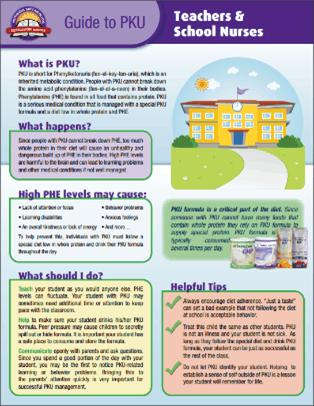Starting at a new school is a time of excitement and nervousness for every child and his/her parents. As a parent of a child with a metabolic disorder, you might feel overwhelmed by the task of preparing your child to start school. However, with good planning and clear communication between your family, the school, and your metabolic team, your child should settle into school life easily.
Planning Before the Start of School

When your child starts at a new school, it’s very important to set up a meeting with the relevant faculty and staff. This may include the principal or dean, the school nurse, and your child’s primary/home room teacher. If your child participates in sports or after-school programs, be sure to also include the supervisor of this activity. During this meeting, you can explain your child’s metabolic disorder and the importance of the low protein diet and metabolic formula.
The school staff will help you with any necessary paperwork. This is a good time to ask questions to help develop a daily plan for your child’s formula and food. Remember, your metabolic team is there to help you with these transitions. Ask your metabolic dietitian if she can provide support in communicating with your child’s school.
Helpful Questions to Ask your Child’s School
- What level of supervision is there at lunch and snack times? Who will provide this supervision?
- Is there a school district dietitian or food services manager I can work with to establish an appropriate meal plan for my child?*
- Will my child be able to drink their formula during class?
- Is there a refrigerator where my child can keep their formula?
- What documentation do you require to ensure my child’s diet and formula needs are met?
*In the U.S., most inherited metabolic disorders are included as medical diagnoses included in the Rehabilitation Act (section 504) and the Americans with Disabilities Act. Federally funded school lunch programs are legally required to provide an appropriate meal option for children with special needs. Specific regulations vary state-to-state, so ask your metabolic team for more information.
Drinking Formula at School
It’s important to spread formula intake throughout the day. For most children, this means drinking one or two servings of formula at school each day.
Formula Tips
- Establish a written plan with the school outlining how, when, and where your child will drink their formula.
- Bring formula to school pre-mixed in a leak-proof shaker bottle.
- No access to a refrigerator? Use a shaker bottle that has a separate powder compartment at the bottom to store a pre-measured portion of formula. Simply add the powder to cold water from a drinking fountain.
- Opt for a ready-to-drink option that can be stored in a lunch box with an ice pack. This also ensures your child won’t forget to take their formula when it’s right there with their lunch!
Nutricia offers a selection of ready-to-drink (RTD) formula options for your convenience and flexibility. Using a ready-to-drink option could simplify your child’s formula experience at school or an after-school activity. Request a sample of one of our RTD formula options today!

Low Protein Lunches at School
Depending on where you live and the school your child attends, school-provided lunch may be an option for your child. Some schools will order specialty low protein foods or prepare them if they are provided. Other schools may be willing to adapt their typical menu to prepare low protein options. Discuss the available options with the school’s food service manager or dietitian.
You may prefer to pack your child’s lunches from home. Ask your child’s teacher or lunchtime supervisor how they can assist with the tracking of your child’s intake. You may find it easiest to have your child bring home any leftovers (rather than throwing them away), so you can easily see how much was eaten.


Packed Lunch Ideas
- Low protein pasta salad for kids
- Low protein fruit salad such as, Apple or Watermelon Salad
- Cut up vegetables with low protein Ranch dip or Roasted Cauliflower Hummus
- Low protein snacks such as low protein chips, puddings, dairy-free yogurt alternatives and fruit cups
The information in this blog is not meant to replace professional medical advice, always consult your metabolic healthcare professional before making any changes to the management of your child’s disorder.
Nutricia North America offers a range of products that are medical foods for the dietary management of inborn errors of metabolism and must be used under medical supervision.
© 2021 Nutricia North America
